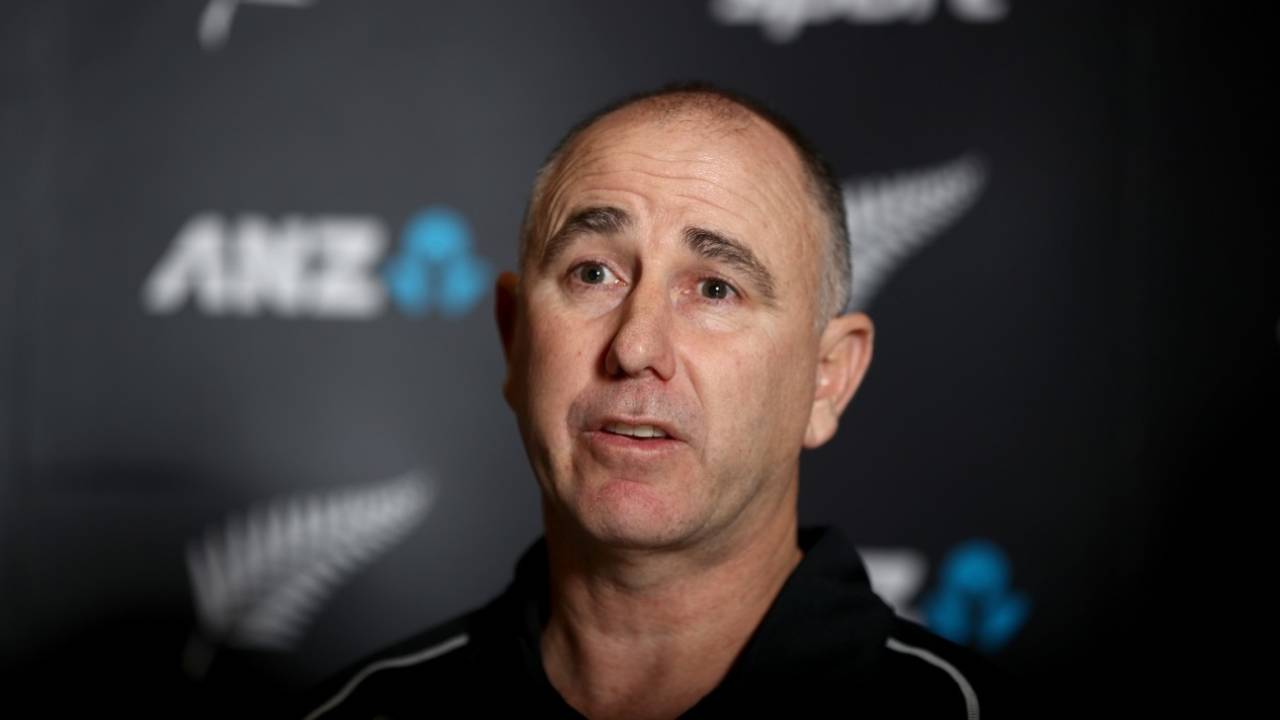Five tasks on Gary Stead's to-do list
With two world tournaments scheduled in the next two years, New Zealand's new head coach will have his task cut out for him when he officially begins his role on September 1
Andrew McGlashan
16-Aug-2018
Gary Stead addresses the media • Getty Images
Following Mike Hesson's decision to step down with a year left on his contract as New Zealand coach, the job has been handed to Gary Stead, the former New Zealand batsman, whose most recent role has been coach of Canterbury. What might his to-do list look like when he officially begins his role on September 1?
Test match fine-tuning
New Zealand's Test team is in pretty solid shape. In the last home season, they won three matches out of four - including a first series win over England at home since in 34 years - and, since 2011, only South Africa and Australia have beaten them in series on their soil. But there is always work to be done, and Stead's first challenge will come overseas against Pakistan in the UAE (the squad for which was picked by Hesson before he left).
Jeet Raval's encouraging start as an opener hit a blip against England with scores of 3, 5 and 17, while in the UAE, the balance of the side will pose some questions if they want to field two spinners. Slightly longer-term, Stead's two-year contract includes an away series in Australia - and a rare Boxing Day Test - alsongside home series against India and England, all in a bumper 2019-2020 season. A hat-trick of success in those series, or even two out of three, would define this generation of New Zealand Test cricketers.
Williamson's workload
While some sides have gone down the split-captaincy route, New Zealand have stuck with one man. Kane Williamson has a lot on his plate as skipper in all three formats and as a batsman with a huge weight on his shoulders. His numbers as captain are up in both Tests (average 54 v 49) and ODIs (49 v 45) but a little down in T20s (30 v 32). It is the shortest format which provokes the debate when Williamson's workload comes up, although his IPL success shows he remains a top-quality T20 batsman when at his best. He has occasionally been rested from ODIs and T20Is, but with the World Cup (2019) and World T20 (2020) to build for, Stead may be reluctant to do that too often.
World Cup build-up
It is the first big-ticket event for Stead to focus on and there is less than a year before it begins. In NZC's perfect plan, Hesson would have taken them to the World Cup then stepped down but now Stead has to pick up the baton. Once Stead has the chance to pick his own squad, it will be interesting to see how many of his own ideas he brings to areas such as the top order and the question marks over the power in the middle. How any changes are accommodated will be key.
In 2015, New Zealand timed their run-in perfectly, dismantling teams at home to build confidence, but the main event was also on their own patch. Also, in 2015 the IPL came after the World Cup. This time it's immediately before meaning Stead will have limited control over many of his key players before they reach England. That, of course, is a factor for many sides, but the player pool in New Zealand is not as vast as some other countries so injuries would really hurt.
Specialist help
After the World Cup, white-ball thoughts will turn to the 2020 World T20 in Australia. New Zealand somewhat lost their mojo last summer and even while Hesson was in charge, there was talk of bringing in a specialist coach for the T20. Though Stead has been given the main job in all three formats, he has a remit to recruit people to focus on certain areas - a T20 man seems very likely. Stead, himself, mentioned names such as Stephen Fleming, Shane Bond and Daniel Vettori.
"I'm not the fountain of knowledge or anything like that, so having different ideas coming in, I think that's important," he said. "The modern-day cricketer, they need to hear different voices, and they need to be able to filter what's right for them and what's not. Being able to bring in different people to grow their understanding and grow their knowledge, I think that's really important for the team."
The next generation
Stead's initial contract is for two years but, you would imagine, he would like the job longer than that. Any coach in a position for a decent length of time is likely to oversee some significant change of personnel. Hesson was central to the captaincy upheaval between Ross Taylor and Brendon McCullum and then had to guide the leadership change from McCullum to Williamson.
Stead may not have anything that dramatic, but is likely to see Taylor, at least, bring his career to a close, which will create a significant hole in the batting. He will need to keep a close eye on what is coming through the set-up below - he will have a strong idea now given his lengthy spell as a domestic coach - and although not directly part of his role, the expanded New Zealand A system will be crucial.
Andrew McGlashan is a deputy editor at ESPNcricinfo
